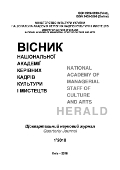PROVIDING A MODEL TO ANALYZE THE IMPACT OF TOURISM DEVELOPMENT ON SUSTAINABLE ECONOMIC GROWTH: COMPARISON OF EUROPEAN DEVELOPED AND ASIAN DEVELOPING COUNTRIES
DOI:
https://doi.org/10.32461/2226-3209.1.2018.177217Анотація
Abstract. Studies and research have shown that many theorists and international organizations have already started to discuss the development of tourism due to the importance of tourism and its impact on economic growth and socio-cultural development. In some developed countries tourism development not only does not lead to economic growth, but even as a result of significant costs and a reduction in the level of social welfare in their society.However, recently a new approach has criticized both aspects of this relationship, which suggests that this is not a self-help relationship. In this regard, the purpose of this study is to determine whether economic growth in some countries has led to an increase in economic development due to the expansion of tourism activity over the past two decades or not. Therefore, algorithm sample of 24 countries including Iran has been used, indicating that this relationship exists in more developed countries and it makes sense of tourism as a driving force for economic development for less developed countries and even in developing countries.
Keywords: Tourism, Economic Development; Economic Sustainability; Structural Balance Model
Посилання
García, P. J. C., Fernández, J. I. P., &Rivero, M. S. El crecimientoturísticocomo un determinante del
desarrolloeconómicoenlospaísespobres. Unanálisismultivariante.
Archer, Brian. (1995). “Importance of Tourism for the Economy of Bermuda.” Annals of Tourism Research,
(4): 918-30
Ashley, Caroline, Peter de Brine, Amy Lehr, and Hannah Wilde (2007). The Role of the Tourism Sector in
Expanding Economic Opportunity. Cambridge: Kennedy School of Government, Harvard University.
Assaf, A. George, and Alexander Josiassen. (2012). “Identifying and Ranking the Determinants of Tourism
Performance: A Global Investigation.” Journal of Travel Research, 51 (4): 388-99.
Assaker, Guy, Rob Hallak, Vincenzo Esposito, and Peter O’Connor. (2013). “An Empirical Operationalization
of Countries’ Destination Competitiveness Using Partial Least Squares Modeling.” Journal of Travel Research. DOI:
1177/0047287513481275.
Craig Webster, Stanislav Ivanov.(2014).Transforming competitiveness into economic benefits: Does tourism
stimulate economic growth in more competitive destinations?. Tourism Management 40 (2014) 137e140
Pablo Juan Cárdenas-García, Marcelino Sánchez-Rivero, and Juan Ignacio Pulido Fernández.(2013). Does
Tourism Growth Influence Economic Development?. Journal of Travel Research 2015, Vol. 54(2) 206– 221
Ding Du, Alan A. Lew, and Pin T. Ng.(1014). Tourism and Economic Growth. Journal of Travel Research 1–11
Ritchie, Brent J.R & Crouch, Geoffrey I (2003), " The Competitive Destination" a sustainable tourism perspective
Nunkoo, Robin, and HaywanteeRamkissoon. (2012). “Structural Equation Modelling and Regression Analysis
in Tourism Research.” Current Issues in Tourism, 15 (8): 777-802.
P11.Pabl .11 o-Romero, Maria, and Jose A. Molina. (2013). “Tourism and Economic Growth: A Review of Empirical Literature.”
Tourism Management Perspectives, 8:28-41.
##submission.downloads##
Номер
Розділ
Ліцензія
Автори, які публікуються у цьому журналі, погоджуються з наступними умовами:
1. Автори залишають за собою право на авторство своєї роботи та передають журналу право першої публікації цієї роботи на умовах ліцензії Creative Commons Attribution License International CC-BY, котра дозволяє іншим особам вільно розповсюджувати опубліковану роботу з обов'язковим посиланням на авторів оригінальної роботи та першу публікацію роботи у цьому журналі.
2. Автори мають право укладати самостійні додаткові угоди щодо неексклюзивного розповсюдження роботи у тому вигляді, в якому вона була опублікована цим журналом (наприклад, розміщувати роботу в електронному сховищі установи або публікувати у складі монографії), за умови збереження посилання на першу публікацію роботи у цьому журналі.
3.Політика журналу дозволяє і заохочує розміщення авторами в мережі Інтернет (наприклад, у сховищах установ або на особистих веб-сайтах) рукопису роботи, як до подання цього рукопису до редакції, так і під час його редакційного опрацювання, оскільки це сприяє виникненню продуктивної наукової дискусії та позитивно позначається на оперативності та динаміці цитування опублікованої роботи.

